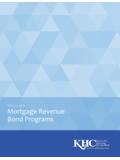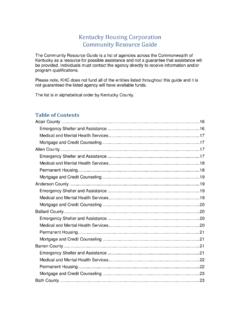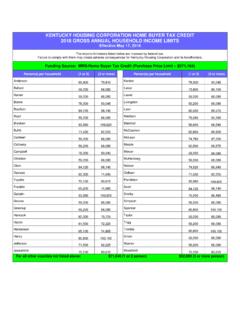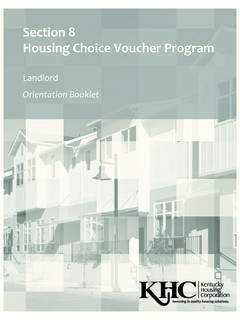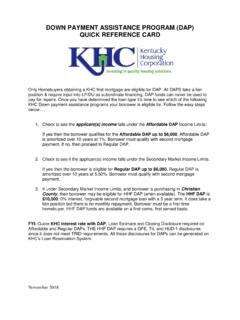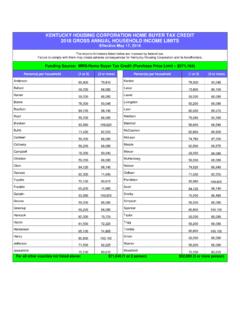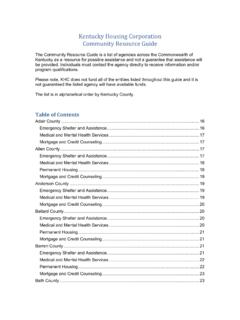Transcription of ELECTRONIC SIGNATURE REQUIREMENTS FOR …
1 ELECTRONIC SIGNATURE REQUIREMENTS FOR LENDERS June 2015 Page 1 of 8 Purpose The ELECTRONIC Signatures in Global and National Commerce (ESIGN) Act (15 7001-7006), enacted in 2000, permits, but does not require, the use of ELECTRONIC signatures (e-signatures). ESIGN generally: Applies to all transactions if the consumer affirmatively consents to the use of ELECTRONIC procedures unless the transaction is specifically excluded under the terms of the Act itself. Permits the use of an e- SIGNATURE in any transaction if both parties consent to the usage. Dictates that any document in ELECTRONIC form or executed with an e- SIGNATURE is fully enforceable.
2 Sets forth ELECTRONIC record retention REQUIREMENTS . Provides that ELECTRONIC records are fully admissible in any legal proceeding. In addition, Kentucky has adopted the Uniform ELECTRONIC Transactions Act (UETA). The Federal Housing Administration (FHA), USDA s Rural Housing Service (RHS), Department of Veteran s Affairs (VA) and Fannie Mae allow ELECTRONIC closings (e-closings). The purpose of this policy is to notify lenders of Kentucky Housing Corporation (KHC) REQUIREMENTS regarding e-signatures and e-closings. Definitions Attribution- The process of associating the identity of a signer with their SIGNATURE . Authentication- The process used to confirm a signer s identity as a party to the transaction.
3 Authoritative Copy- The Authoritative Copy of an electronically-signed document refers to the ELECTRONIC record that is designated by the lender or the holder as the controlling reference copy. Biometric SIGNATURE - The unique pattern of a physical feature such as a fingerprint, iris, or voice as recorded on a database for future attempts to determine or recognize a person s identity. Click Wrap Agreement- A type of agreement used with software licenses and online transactions in which a user must agree to terms and conditions prior to using the product or service. Most require the consent of the end user by clicking an OK, I Accept, or I Agree button on a pop-up window or dialogue box.
4 Page 2 of 8 Closing Disclosure- A form which must be provided to consumers three business days before they close on a loan, designed to provide disclosures that will be helpful to consumers in understanding all the costs of a transaction. Digital SIGNATURE - Digital signatures are a subset of ELECTRONIC signatures that utilize public key cryptography which, in turn, involves two related keys: a unique private key for the user, which encrypts the information, and a corresponding public key which unlocks the information and verifies the user s identity. E-Closing - The act of closing a mortgage loan electronically. Some or all of the closing documents are accessed and executed via the web in a secure ELECTRONIC environment.
5 ELECTRONIC Record- A contract or other record created, generated, sent, communicated, received, or stored by ELECTRONIC means. ELECTRONIC SIGNATURE - Any ELECTRONIC sound, symbol, or process attached to, or logically associated with, a contract or other record and executed or adopted by a person with the intent to sign the record. E- SIGNATURE - ELECTRONIC SIGNATURE . E-Signer- A person who places an ELECTRONIC SIGNATURE on a document. IVES (Income Verification Express Services) ELECTRONIC Service REQUIREMENTS - A document that includes the REQUIREMENTS for the suggested framework that all IVES Participants must adhere to in order to use ELECTRONIC signatures for IRS Form 4506-T. Loan Estimate- A form, which must be provided to consumers within three business days after they submit a loan application, designed to provide disclosures that will be helpful to consumers in understanding the key features, costs, and risks of the mortgage for which they are applying.
6 Out-of-Band/Wallet Authentication- Out-of-Band Authentication means that a transaction that is initiated via one delivery channel ( , Internet) must be re- authenticated or verified via an independent delivery channel ( , telephone) in order for the transaction to be completed. Out-of-wallet Authentication relies on information that is not often publicly available and is difficult for imposters to identify. Personal Identifiable Information (PII)- Any information that could potentially identify a specific individual. Public Key Infrastructure (PKI) the combination of software processes and services that enable an organization to secure its communications and business transactions. It is based upon the exchange of digital certificates between authenticated users and trusted resources.
7 Page 3 of 8 Private Key- An encryption/decryption value known only to the parties who exchange information. Public Key- A value provided by some designated authority as an encryption key that is known to everyone and, combined with a private key derived from the public key, can be used to effectively encrypt messages and digital signatures. RESPA The Real Estate Settlement Procedures Act, which ensures that consumers are provided with helpful information about the cost of mortgage settlements and protected from unnecessarily high settlement charges. Special Information Booklet- The booklet prepared by the Department of Housing and Urban Development pursuant to RESPA to help persons understand the nature and costs of settlement services.
8 Third-Party Documents - Documents that are originated and signed outside the control of the lender. An example of a third-party document is a sales contract. TILA The Truth in Lending Act, which provides uniform disclosures to make it easier for consumers to shop wisely for credit and helps ensure that consumers understand the financial risks associated with credit. TRID Disclosures The Loan Estimates, Closing Disclosures and Special Information Booklets required to be provided to consumers pursuant to TRID. TRID Rule - The TILA-RESPA Integrated Disclosure (TRID) Rule, effective August 1, 2015. This rule requires lenders to provide consumers with a Loan Estimate, Closing Disclosure and Special Information Booklet.
9 Under TRID, the initial Truth-in-Lending Disclosure and RESPA Good Faith Estimate are combined into the new Loan Estimate form and the final Truth-In-Lending Disclosure and RESPA HUD-1 are combined into the new Closing Disclosure. Uniform ELECTRONIC Transactions Act (UETA)- A uniform act, the purpose of which is to remove barriers to ELECTRONIC commerce by validating and effectuating ELECTRONIC records and signatures. E-S igning and ELECTRONIC Delivery of TRID Disclosures KHC allows ELECTRONIC delivery of TRID disclosures and accepts e- signatures on TRID disclosures. If a lender chooses to allow applicants to confirm receipt of TRID disclosures via e- SIGNATURE , the lender must ensure that the disclosures are delivered to the consumer with the option for ELECTRONIC signatures.
10 Lenders must provide consumers with notice of their rights, and this notice must include a statement that the applicant s SIGNATURE is about to be applied to, or associated with, the receipt confirmation. Page 4 of 8 However, prior to delivering TRID disclosures to consumers electronically, a consumer must affirmatively consent electronically to the use of ELECTRONIC notices, in a manner that reasonably demonstrates that the consumer has Internet access, hardware and software suitable for the e-document receipt task, and the knowledge to use these things to receive, open, and use any documents Lender will send electronically. One example of how the lender may accomplish this is by creating a test document in the format it will use throughout the course of the transaction and follow the steps outlined below.
